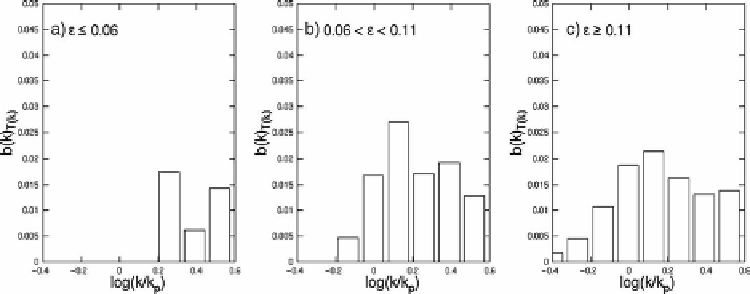Geoscience Reference
In-Depth Information
Figure 5.25 The shift towards the spectral peak of the histogram of the breaking probability as a
function of the mean steepness in each
±
15% relative wavenumber bin. (a) for
peak
<
0
.
06 (corre-
sponding to well-developed seas) breaking occurs well above the spectral peak. For the steeper seas
in (b) 0
.
<
peak
<
.
peak
>
.
11, the histogram peak moves towards the spectral
peak. Figure is reproduced from
Banner
et al.
(
2000
)
06
0
11 and (c)
0
©
American Meteorological Society. Reprinted
with permission
Figure 5.25
shows how the peak of the breaking probability distribution shifts from well
above the spectral peak to close to the spectral peak as the dominant wave slope
peak
increases. This is consistent with the findings of
Ding & Farmer
(
1994
) who found from
their relatively old wind-sea conditions that the mean breaking-event speed is consider-
ably smaller than the phase speed of the dominant wind seas. It also follows the trend
reported by
Gemmrich & Farmer
(
1999
), who observed that the peak of the normalised
breaking-frequency distribution was located well above the spectral peak frequency for
typical mature wind seas.
While negligible breaking is observed at the spectral peak for the wave fields with
peak
<
06, the wave breaking occurs at higher wavenumbers (
Figure 5.25
a). If the peak
steepness is higher (0
0
.
11 in
Figure 5.25
b), the wave breaking histogram
moves closer to the spectral peak, and even below the peak at
.
06
<
peak
<
0
.
11 (
Figure 5.25
c).
For a standard unimodal spectral shape, which occurs under simple wave-development
conditions, e.g. JONSWAP spectrum
(2.7)
, the peak steepness
peak
>
0
.
peak
can be related to the
wind forcing or inverse wave age
U
10
/
c
p
. That is, for young waves, frequent breaking
of the dominant waves is expected, whereas old dominant waves will not be breaking at
all. As mentioned above, this is consistent with other observations (i.e.
Ding & Farmer
,
1994
;
Gemmrich & Farmer
,
1999
), but it has to be kept in mind that generally speaking
the breaking parameter
peak
is not unambiguously related to the wave age. Waves of the
same nominal development stage
U
10
/
peak
due to a
variety of circumstances, for example due to the presence of swell which is quite typical
for the open oceans. These could lead to different breaking probabilities at the spectral
peak and different breaking-frequency distributions for the same nominal wave age.
c
p
may have quite different values of

Search WWH ::

Custom Search